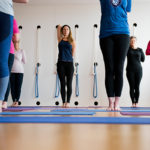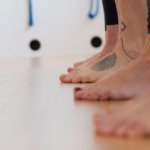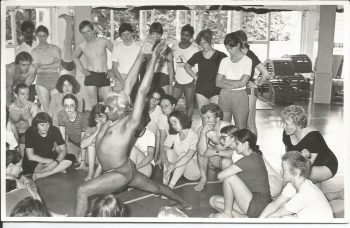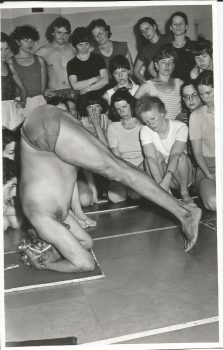
Read on to find out where we are, how to get here and everything else about visiting Yoga Now studio.
Where to find us
We are on the 4th floor of St. Margaret’s House, 151 London Road, Edinburgh, EH7 6AE, UK.
It is a brutal looking office block, right next to the railway tracks at Meadowbank, which is now run by Scot-Art and is full of artists’ studios, galleries and small businesses. It’s the one with ART on the side.
Take the lift or stairs to the 4th floor – Yoga Now is through the double doors, to your right as you leave the lift, to your left if you came up the stairs.
We teach Iyengar Yoga classes, suitable for every body.
How to get here
Lots of buses go along London Road – there is a bus stop outside the building next door. We have bike racks in our car park and by the front door.
You are welcome to use the free car parking beside the building. Enter Meadowbank House car park from Restalrig Road South (aka Smokey Brae) and drive right round to the second building. The entrance is on the far side and also has ART over it.
We will send you the door entry code for the building, by email, when you register for a class. If you forget it, you can ring the buzzer for ‘Galleries / reception’ and someone will let you in – this desk is not occupied full time, so it’s better to bring the code with you.
There are lots of businesses and projects based in the building – there is a primary school in the basement at the time of writing – so don’t worry, you are in the right place!
What to bring
We provide all the equipment you will need, including mats, but if you prefer to use your own, you are welcome to bring it.
Yoga is practiced in bare feet and please wear stretchy clothes – shorts or leggings and a t-shirt. Bring a warm layer for relaxation at the end of the class. You might also like to bring an eye pillow if you have one.
Please don’t drink water during the class. It’s a yoga thing! Feel free to bring some with you for afterwards and there is a small kitchen opposite the lifts where you can refill your bottle.
If you need to go to the toilet during the class, we have flip flops you can borrow.
Choosing your class
We offer classes from Beginners level through to Advanced and teachers mentoring.
Beginners Course / Introductory Course –
Short introduction to Iyengar yoga. This is the best place to start for beginners. You are expected to attend each week for the duration of the course and the syllabus is introduced in a clear and understandable order, each class building on what was taught previously. These short courses are offered a few times each year and the course length varies, usually between 6 and 12 weeks.
Beginners 1 class –
Ongoing classes for beginners who have completed a Beginners / Introductory Course and those wishing to consolidate their understanding of the basic poses.
Beginners 2 class –
For those who have attended Beginners 1 for about a year and feel ready for new challenges. Remember, we all progress at different rates and there are no rules about how long it ‘should’ take to move up a level.
General class –
For everybody! These classes are often a bit longer (90 mins.) so there is time to help students with different levels of experience and to show adaptations / alternative poses as necessary.
Intermediate classes –
For those with at least 2 years’ experience, who are beginning to practice at home and are ready to take their learning further. Inversions – Sirsasana, Sarvangasana, Adho Mukha Vrksasana – are taught regularly at this level.
Advanced classes –
For those with a daily home practice and plenty of experience. These classes will take your understanding of yoga much deeper. You should be able to hold Sirsasana, Sarvangasana and their variations and be prepared to attempt more challenging asanas. You should also be ready to understand the role of the breath and the mind in your practice.
If you are unsure which level class is for you, please email me and I will be happy to help – lucy@yoganowstudio.co.uk
It takes a long time to become an Iyengar yoga teacher – at least 6 years. Training is through mentoring by your teacher and requires a good relationship, based on regular class attendance for at least 3 years, with the same teacher, as well as a passion for the subject. It is a considerable commitment and cannot be undertaken lightly. This ensures that all Iyengar yoga teachers are well trained and have plenty of experience before they begin teaching.
How to pay – all about passes
We use the Tula online booking system and card payments are processed through Stripe.
At Yoga Now, you buy credits which you use to pay for classes. This gives you flexibility – if you find you can no longer make the class you booked for, you can use the credits at another class instead.
Our classes vary in price – longer classes cost more than shorter ones. Also, if you attend regularly, the more often you come to class, the cheaper the credits.
Try a class first – book for a single class to see if it will suit you. Choose your class on the timetable and follow the instructions to register and pay. There will be a drop down menu of pass options and the cheapest one will give you enough credits for that one class.
Book for a term – At the start of each term, we offer Term Passes, which provide enough credits for that class for the term. As usual, you can use the credits at any classes, change your booking etc. by signing in to your account on the website.
Block Passes – 20, 30 or 40 credits. These expire after 10 weeks, so don’t be tempted to buy more credits that you can use! The credits get cheaper the more you buy at once, to reward frequent attendance (it’s the best way to progress).
Credits can be used at any classes but not at Special Events or workshops. All credits have an expiry date – please check your booking confirmation email. More information about booking a class here.
The studio
Yoga Now studio is run by Lucy Brownhall. Lucy began studying Iyengar yoga in 1986 and became an Iyengar yoga teacher in 2002. The studio first opened in 2014 and was extended in 2017, using the money she had put aside to replace the draughty windows on her flat! It is very much a small, local business with a lovely community of students and teachers. We aim to provide a welcoming and inclusive space for everyone who wants to learn more about yoga and to practice together.
We have a lovely big space, with a purpose built rope wall (for yoga kurunta) and all the equipment you might need – mats, blocks, bricks, belts, blankets, bolsters and chairs. This equipment is used in many ways, to assist us to achieve better alignment in asanas, to challenge us to work a little harder or to educate us to understand an action better. It is also used to help those who otherwise would struggle to achieve a pose.
The studio has great, Far Infrared heating panels on the ceiling and a wooden floor – to make it a clean, warm and pleasant space to practice in.
Health and safety measures
We are lucky to have a really large and airy studio. Previously, we have held workshops for up to 50 students in the space. At the moment, our class sizes are limited to 24- 34, in order to give everyone plenty of space. The class size limit may change if we feel it is appropriate but we always make sure everyone has lots of space. We also have plenty of windows which we can open to maintain a good flow of fresh air.
Check out our FAQ page for more information. If you have any questions, please do get in touch and I will be very happy to help! lucy@yoganowstudio.co.uk





 It seems such a long way from the Guru/Shishya relationship. Here are a couple of photos from 1981 when a small group of Scottish students went on an intensive with Guruji. Look how they are learning! And compare with how we are learning in the age of Covid-19.
It seems such a long way from the Guru/Shishya relationship. Here are a couple of photos from 1981 when a small group of Scottish students went on an intensive with Guruji. Look how they are learning! And compare with how we are learning in the age of Covid-19. But, of course, it is better than nothing and we all feel heartfelt gratitude for all those students who continue loyally to attend our regular classes. It is lovely to see your faces each week, to help us all to connect during this period of relative isolation. It is a great honour to help you to build up trust and confidence in your own inner teacher and many of you have reported how doing classes in your own home has helped to establish a home practice.
But, of course, it is better than nothing and we all feel heartfelt gratitude for all those students who continue loyally to attend our regular classes. It is lovely to see your faces each week, to help us all to connect during this period of relative isolation. It is a great honour to help you to build up trust and confidence in your own inner teacher and many of you have reported how doing classes in your own home has helped to establish a home practice.